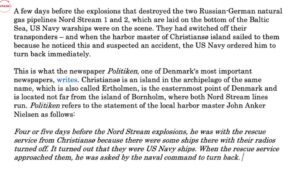A significant new revelation has emerged concerning the obliteration of the Nord Stream pipelines in the Baltic Sea. Recent evidence suggests that U.S. warships were maneuvering near the Nord Stream explosion with their transponders deactivated just before the incident. If verified, this revelation might incriminate the United States with a profound and clandestine role in a major geopolitical event in recent European history. The Nord Stream pipelines, which conveyed natural gas from Russia to Europe, were sabotaged in September 2022, resulting in an energy crisis in Europe. The incident has generated significant conjecture, with multiple governments and independent analysts assigning blame; nevertheless, the recent disclosures introduce further complications to the probe.
U.S. Naval Vessels and Communications Blackout in Proximity to the Explosion Site
Recent reports indicate that U.S. Navy warships were observed near the Nord Stream pipeline site in the days preceding the explosions. This finding is particularly notable because the ships were operating in radio silence, with their Automatic Identification System (AIS) transponders deactivated, a highly unusual and suspicious action considering the heavily trafficked Baltic Sea.
Danish sailors from Christiansø, a small Danish Island near the explosion site, allegedly observed the atypical conduct of these U.S. Navy boats. Alarmed by their presence and the absence of position broadcasts from the ships, the Danish sailors dispatched a rescue team to investigate. Upon nearing the American battleships, the Danish team was allegedly instructed to vacate the vicinity without delay, suggesting that clandestine activities were occurring.
The conduct of U.S. warships prompts significant inquiries on the objectives of their mission in the Baltic Sea. The deactivation of the transponders indicates a calculated effort to conceal their existence, intensifying conjecture over the U.S. Navy’s prior knowledge of or direct participation in the subsequent sabotage of the pipelines.

The Concealed Narrative: What Led to Its Suppression for Two Years?
One of the most concerning elements of this new material is the assertion that it has been concealed for two years. Reports suggest that Danish officials and the worldwide media were cognizant of the atypical naval operations near the Nord Stream location but opted to conceal the information. This engenders considerable apprehensions regarding transparency and the possibility of political coercion from influential states.
The concealment of this information for two years has facilitated the proliferation of numerous narratives concerning the identity of those responsible for the sabotage. Initial conjecture attributed responsibility to Russia, as Western nations alleged that Moscow detonated its infrastructure to retaliate against Europe for its support of Ukraine. Russia has persistently refuted these allegations, implying those alternative entities potentially NATO or Western intelligence agencies—could be culpable.
If authenticated, this new data could alter the narrative and indicate that the U.S. had a more active involvement than previously believed. The deployment of U.S. naval personnel in the region amid escalating geopolitical tensions between the West and Russia would constitute a significant revelation, especially if they were implicated in or aware of the sabotage.
The Geopolitical Context of the Nord Stream Assault
The Nord Stream pipelines were essential infrastructure for Europe’s energy supply, transporting natural gas from Russia to Germany and other European nations. Constructed beneath the Baltic Sea, Nord Stream 1 and Nord Stream 2 exemplified an intensification of commercial relations between Europe and Russia, notwithstanding political discord. The pipelines sparked significant controversy in the United States and Eastern European countries, which contended that they heightened Europe’s reliance on Russian energy and undermined the continent’s determination to resist Russian aggression.

The Nord Stream pipelines were destroyed amid the ongoing conflict in Ukraine, during which Western nations offered significant military and financial assistance to Kyiv in its defense against the Russian invasion. During the explosion in September 2022, some observers regarded it as a pivotal moment in the energy conflict between Russia and the West. The assault incapacitated Europe’s capacity to import natural gas from Russia, compelling numerous European nations to pursue alternate energy sources, and intensifying an already critical energy crisis throughout the continent.
Should U.S. involvement in the sabotage be substantiated, it would indicate that Washington perceived the destruction of Nord Stream as a strategic maneuver to diminish Russia’s power and compel Europe to disengage from Russian energy sources. Nonetheless, this would imply that the U.S. was prepared to undermine essential infrastructure in Europe, perhaps upsetting its allies in the pursuit of overarching geopolitical objectives.
The Involvement of Denmark and Sweden in the Inquiry
Denmark and Sweden, the nations nearest to the explosion location, have taken a prominent part in the investigation of the Nord Stream sabotage. Following the attack, both nations-initiated investigations and sought evidence at the explosion site. Nevertheless, the inquiry has progressed sluggishly, and the findings have remained predominantly confidential, fueling concerns of a potential cover-up.
Given the recent proof of U.S. Navy presence in the region, inquiries are emerging into Denmark and Sweden’s awareness of American operations and their potential complicity in concealing this information from the public. The engagement of Danish sailors with U.S. warships indicates that local authorities possessed some awareness of the atypical naval operations preceding the explosion. The American military’s failure to elucidate their presence at that time simply heightens the curiosity.
Certain commentators have conjectured that Denmark and Sweden, both members of NATO, may have experienced pressure from the United States and other allies to refrain from attributing blame to American forces. This elucidates why critical aspects of the probe have remained concealed from the public, despite escalating suspicions of Western complicity in the sabotage.

Consequences for U.S.-European Relations
Should the U.S. be implicated in the Nord Stream sabotage, the repercussions for transatlantic relations may be significant. Numerous European countries, especially Germany, have been contending with the economic ramifications of the pipeline demolition, and the disclosure of American cooperation would be perceived as a betrayal. The United States, which has always positioned itself as Europe’s defender against Russian aggression, would find such a controversy detrimental to trust and collaboration within NATO and other international alliances.
Furthermore, validation of U.S. participation in the assault would substantiate Russian claims that the West is not merely safeguarding Ukraine but is actively conducting a proxy war against Russia, employing energy as a weapon. This would exacerbate tensions between Russia and the West and potentially result in a wider conflict. The Nord Stream sabotage is one of the most enigmatic and significant occurrences of the Ukraine conflict. The recent evidence of U.S. warships clandestinely operating in the region enhances curiosity and prompts essential inquiries regarding the perpetrators of the attack and their intentions.
The presence of U.S. naval warships near the Nord Stream bombing site, functioning under radio silence shortly before the explosion, is a significant advance in the investigation of the pipeline demolition. If verified, this information could incriminate the U.S. in the sabotage, significantly transforming the narrative around the incident and generating profound inquiries about the involvement of Western forces in the Ukraine conflict. The international community will closely monitor the ongoing inquiry to determine if these fresh disclosures contribute to a comprehensive understanding of the circumstances behind the Nord Stream sabotage. The mystery intensifies, as the identity of the perpetrator responsible for the destruction of one of Europe’s essential energy conduits remains unclear.
Follow us on social media: Instagram, Threads & Twitter X @nya360_ YouTube & Facebook @nya360.





